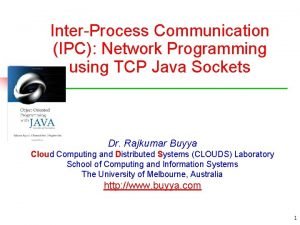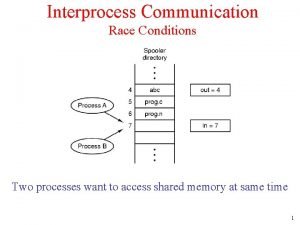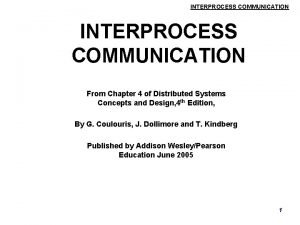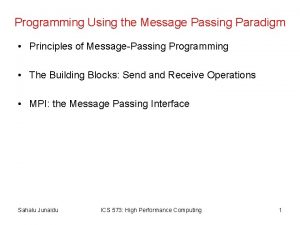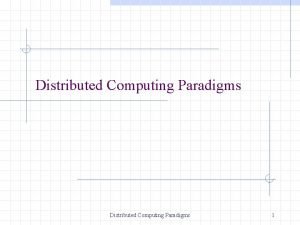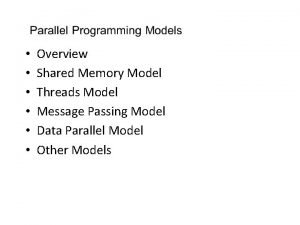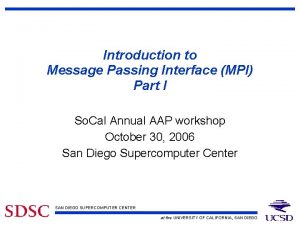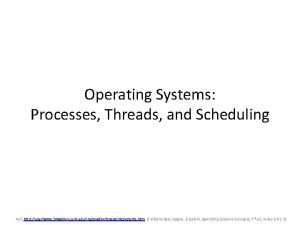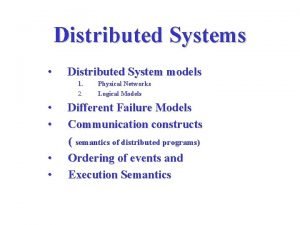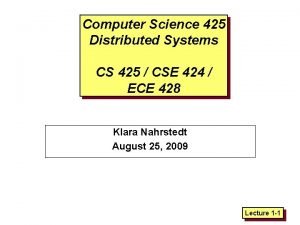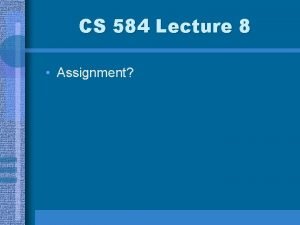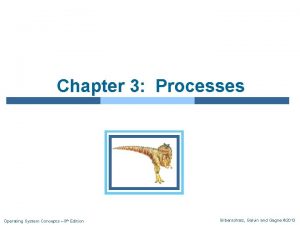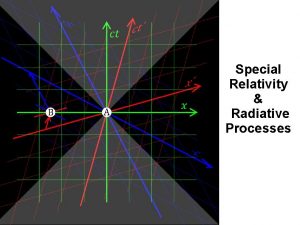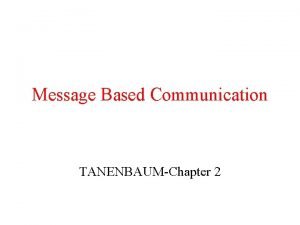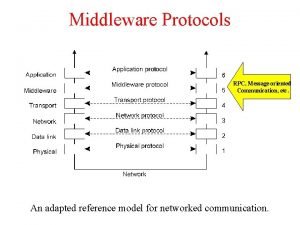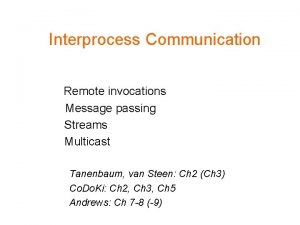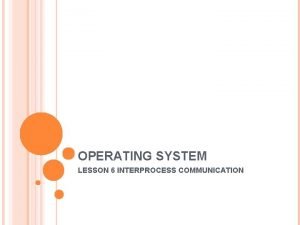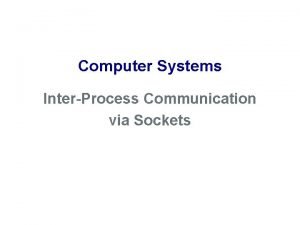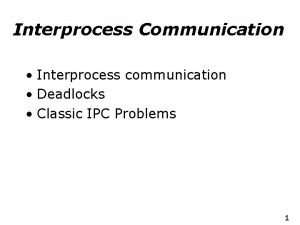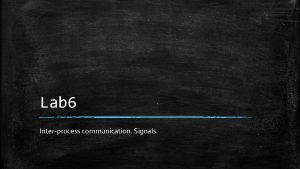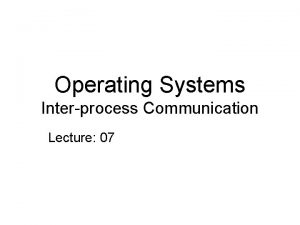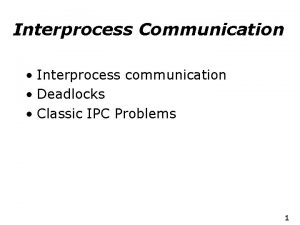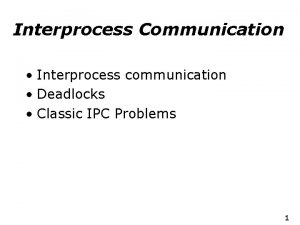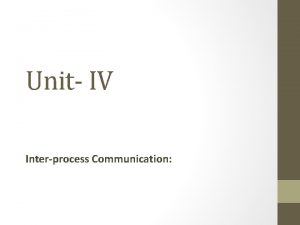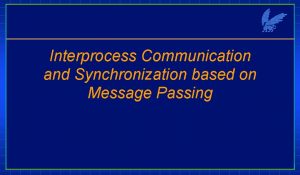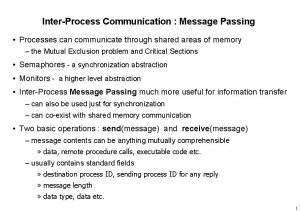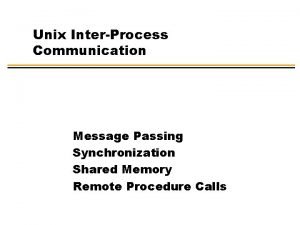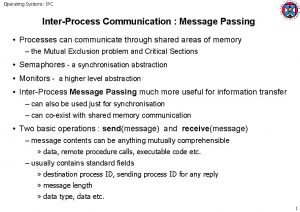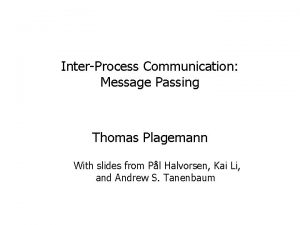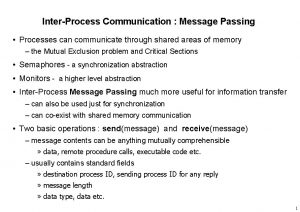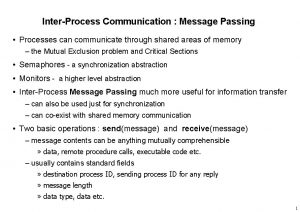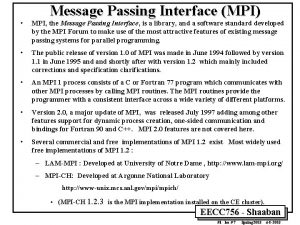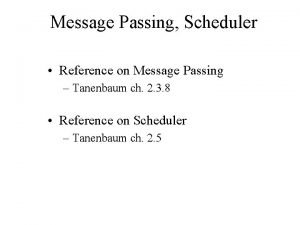Ch 3 Interprocess Communication Remote invocations Message passing
































- Slides: 32

Ch 3. Interprocess Communication Remote invocations Message passing Tanenbaum, van Steen: Ch 2 (Ch 3) Co. Do. Ki: Ch 2, Ch 3, Ch 5 Andrews: Ch 7 -8 (-9)

Middleware Protocols General purpose services -Naming, “browsing” -Security -Atomicity -Higher-level communication -RPC, RMI -Message passing -Reliable multicast An adapted reference model for networked communication.

Remote Procedure Calls • Form: see Andrews, p. 363 • Example: Andrews, Fig. 8. 2 • Notice: – “passive” routines – available for remote clients – executed by a local worker process, which is invoked by the local infrastructure • Implementation: see Tv. St, Ch. 2. 2

RPC: a Schematic View System A System B X, Y, Y Z FNCT(a, b) c: ={comp} return c. Thread P … Y=FNCT(X, Y) … a: =X; b: =Y; RPC package

Implementation of RPC (1) • RPC components (Bacon, Fig. 15. 7) : – RPC Service (two stubs) • interpretation of the service interface • packing of parameters for transportation – Transportation service: node to node • responsible for message passing • part of the operating system • Name service: look up, binding – name of procedure, interface definition

Passing Value Parameters Steps involved in doing remote computation through RPC

Writing a Client and a Server The steps in writing a client and a server in DCE RPC.

Binding a Client to a Server Client-to-server binding in DCE.

Implementation of RPC (2) Server: who will execute the procedure? • One server process – infinite loop, waiting in “receive” – call arrives : the process starts to execute – one call at a time, no mutual exclusion problems • A process is created to execute the procedure – parallelism possible – overhead – mutual exclusion problems to be solved • One process, a set of thread skeletons: – one thread allocated for each call

Distributed Objects • • • Remote Method Invocation ~ RPC; see Fig. 2 -16. A distributed interface – binding: download the interface to the client => proxy – “server stub” ~ skeleton The object – resides on a single machine (possible distribution: hidden) – if needed: “object look” through an adapter (see: Fig. 3 -8) – an object may be persistent or transient Object references: – typically: system-wide – binding: implicit or explicit resolving of an object reference Binding and invocation: see Fig. 2 -17 Examples: CORBA, DCOM (Ch. 9. 1, 9. 2)

Distributed Objects Fig. 2 -16. Common organization of a remote object with client-side proxy.

Object Adapter Fig. 3 -8. Organization of an object server supporting different activation policies.

Binding a Client to an Object Distr_object* obj_ref; obj_ref = …; obj_ref-> do_something(); //Declare a systemwide object reference // Initialize the reference to a distributed object // Implicitly bind and invoke a method (a) Distr_object obj. Pref; Local_object* obj_ptr; obj_ref = …; obj_ptr = bind(obj_ref); obj_ptr -> do_something(); //Declare a systemwide object reference //Declare a pointer to local objects //Initialize the reference to a distributed object //Explicitly bind and obtain a pointer to … // … the local proxy //Invoke a method on the local proxy (b) Fig. 2 -17. • (a) Example with implicit binding using only global references • (b) Example with explicit binding using global and local references

Parameter Passing Fig. 2 -18. The situation when passing an object by reference or by value. Copying must not be hidden! Why?

Design Issues • Language independent interface definition • Exception handling • Delivery guarantees RPC / RMI semantics – maybe – at-least-once – at-most-once • Transparency (algorithmic vs behavioral)

Communication: Message Passing Node Net Process A Process B … X=f(. . ); send X to B. . . … receive X from A Y=f(X); . . . X: 10 X: 5 OS kernel xxxxx Data Communication OS procedure send buffer 10 Network kernel procedure receive A<=>B xxxxx

Binding (1) • Structure of communication network – one-to-one (two partners, one shared channel) – many-to-one (client-server) – one-to-many, many-to-many (clientservice; group communication) • Types of message passing – send, multicast, broadcast – on any channel structure

Binding (2) Time of binding – static naming (at programming time) – dynamic naming (at execution time) • explicit binding of channels • implicit binding through name service

Persistence and Synchronicity in Communication (1) General organization of a communication system in which hosts are connected through a network

Persistence and Synchronicity in Communication (2) • Persistent communication a submitted message is stored in the system until delivered to the receiver (the receiver may start later, the sender may stop earlier) • Transient communication a message is stored only as long as the sending and receiving applications are executing (the sender and the receiver must be executing in parallel)

Persistence and Synchronicity in Communication (3) Persistent communication of letters back in the days of the Pony Express.

Persistence and Synchronicity in Communication (4) • Asynchronous communication the sender continues immediately after submission • Synchronous communication the sender is blocked until • the message is stored at the receiving host (receipt-based synchrony) • the message is delivered to the receiver (delivery based) based • the response has arrived (response based) based

Persistence and Synchronicity in Communication (5) a) b) Persistent asynchronous communication Persistent synchronous communication

Persistence and Synchronicity in Communication (6) c) d) Transient asynchronous communication Receipt-based transient synchronous communication

Persistence and Synchronicity in Communication (7) e) f) Delivery-based transient synchronous communication at message delivery Response-based transient synchronous communication

The Message-Passing Interface (MPI) • Traditional communication: sockets • Platform of concern: highperformance multicomputers • Issue: easy-to-use communication for applications • Sockets? No: wrong level, non-suitable protocols Þ a new message passing standard: MPI § designed for parallel applications, transient communication § no communication servers § no failures (worth to be recovered from)

The Message-Passing Interface (MPI) Primitive Meaning MPI_bsend Append outgoing message to a local send buffer MPI_send Send a message and wait until copied to local or remote buffer MPI_ssend Send a message and wait until receipt starts MPI_sendrecv Send a message and wait for reply MPI_isend Pass reference to outgoing message, and continue MPI_issend Pass reference to outgoing message, and wait until receipt starts MPI_recv Receive a message; block if there are none MPI_irecv Check if there is an incoming message, but do not block Some of the most intuitive message-passing primitives of MPI.

Message-Queuing Model (1) 2 -26 Four combinations for loosely-coupled communications using queues.

Message-Queuing Model (2) Primitive Meaning Put Append a message to a specified queue Get Block until the specified queue is nonempty, and remove the first message Poll Check a specified queue for messages, and remove the first. Never block. Notify Install a handler to be called when a message is put into the specified queue. Basic interface to a queue in a message-queuing system.

General Architecture of a Message. Queuing System (1) The relationship between queue-level addressing and network-level addressing.

General Architecture of a Message-Queuing System (2) 2 -29. The general organization of a message-queuing system with routers.

Message Brokers The general organization of a message broker in a message-queuing system.
 Interprocess communication in linux
Interprocess communication in linux Ipc programming
Ipc programming Message passing os
Message passing os Interprocess communication in os
Interprocess communication in os Race condition in interprocess communication
Race condition in interprocess communication What is multicast communication in distributed system
What is multicast communication in distributed system Android interprocess communication
Android interprocess communication Interprocess communication
Interprocess communication Principles of message passing programming
Principles of message passing programming Desirable features of good message passing system
Desirable features of good message passing system Divergence measures and message passing
Divergence measures and message passing Distributed computation paradigms
Distributed computation paradigms Message passing
Message passing Desirable features of a good message passing system
Desirable features of a good message passing system Message passing model
Message passing model Variational message passing
Variational message passing Message passing interface tutorial
Message passing interface tutorial Quick passing game
Quick passing game Message passing system in distributed system
Message passing system in distributed system System models in distributed systems
System models in distributed systems Message passing system in distributed system
Message passing system in distributed system Erlang message passing
Erlang message passing Message passing interface
Message passing interface Message passing os
Message passing os Special relativity vs general relativity
Special relativity vs general relativity Persuasive message in business communication
Persuasive message in business communication Positive messages in business communication
Positive messages in business communication Business communication chapter 3
Business communication chapter 3 Negative message definition
Negative message definition Persistent and transient communication
Persistent and transient communication 14. what are persuasive messages?
14. what are persuasive messages? Persuasive message in business communication
Persuasive message in business communication Message oriented middleware
Message oriented middleware

